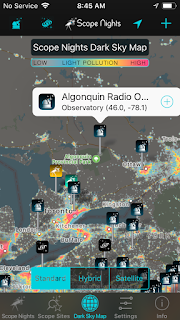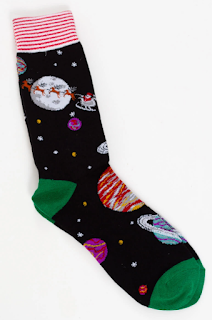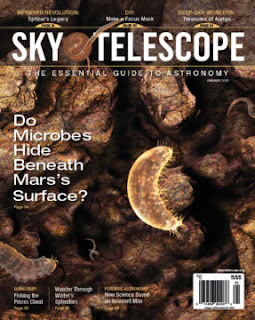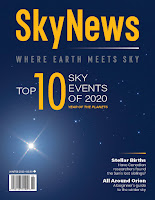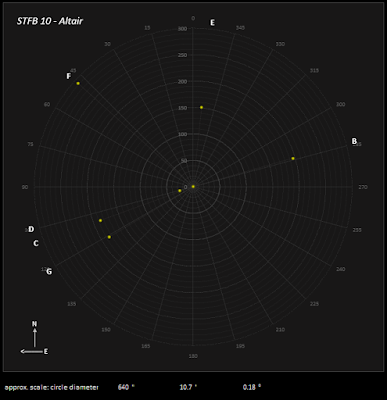locations
I observed (and imaged) from a variety of locations. There was one from—or rather, over—Lachute, Québec. From Ontario, there was St Thomas, Richmond Hill, the York region in general, the Blue Mountains, of course, Mississauga, Toronto, close to home including Holland Landing and Aurora, and Bradford West Gwillimbury. I briefly observed from Pinckney, Michigan. All the BGO imaging was from Halifax, Nova Scotia.
optics used
I was privileged to use a lot of different equipment, for visual astronomy and astrophotography, over the year. I used my Mark I eyeballs, my Bushnell 10x50 binoculars, in equatorial mode, the Meade ETX 90mm Maksutov-Cassegrain (MCT) fork-mounted (RA version) telescope from Charles, and my trusty Super Polaris Celestron 8-inch (SPC8).
At the Carr Astronomical Observatory (CAO), in the Geoff Brown Observatory (GBO), I used the GSO 16" (GSO16) Ritchey-Chrétien telescope (for both visual and photographic) and the Tele Vue 101mm (TV101) refractor. I also tried the GSO 8" RC imaging system (with my camera) in the Sue-Lora Observatory (SLO). It's always a treat to look through Ian W's custom 20" Newtonian Dobsonian.
My brother-in-law Steve brought over his Celestron 60mm 25x spotting scope so we could check out the Moon in front of a star cluster. I looked through a bunch of 'scopes at Bayview Village Park while helping Tess with her ETX 90 GoTo. I continued to use the robotic 24" RC with dual CCD cameras in the Burke-Gaffney Observatory (BGO) at St Mary's University (SMU).
I briefly used a Coronado Personal Solar Telescope (PST) at the Richmond Hill (RH) David Dunlap Observatory (DDO) during a kid's summer camp day. And I continued my training on the DDO 74" telescope (in Cassegrain mode).
photography
Did a bunch of imaging over the year, with robotic camera systems and my own gear.
As mentioned, I continued to use the BGO. As I (soft) completed the Finest NGC project a while ago, I haven't been aiming at New General Catalogue targets per se. Wanted to get the only one that BGO could not see with Lane's ARO rig but a technical issue prevented it. I'll try again in 2020. If it works, then I can claim to have imaged all the Finest with robotic telescopes (in Nova Scotia).
Now I still used BGO but for random miscellaneous stuff. Like comet Africano aka C/2018 W2 and quasar CTA 102.
Doubled-down on a few Messiers, catalogue objects that I have only viewed once before. M100 was amazing.
Arp 330 was fun. Lots of galaxies in a single frame. Some call this the "Golden Chain." Intriguing. My data is not great but I'll try to process it in colour.
Imaged a couple of stars with high proper motion, e.g. Wolf 359. Made calendar notes to return once a year. Once I have three or four frames, I'll trying making movies.
Imaged IK Pegasi, a potential outburst star. Again, I'll image this at least once a year. In case it pops.
Started using the app developed by Lane, the Android version a bit, mostly the Windows product. I have programmed it both for BGO and ARO. It's great getting immediate feedback.
Used the Canon 40D DSLR a bunch. Simple stuff atop a fixed tripod. I used the Sky-Watcher Star Adventurer at the RASC observatory. I used my custom barn door tracker with integrated altitude-azimuth base (BDT+AAB). Fun using that rig. To make polar alignment easier with the BDT, I made a large chart. From the backyard, at long last I successfully imaged a International Space Station (ISS) flyover with Canuck David Saint-Jacques aboard.
And I finally got to use the SLO with my DSLR. Unfortunately, I was coerced into training, the following time slot was booked, and I got dewed out. I was trying for a unique subject, Arp 272, a galaxy cluster in Hercules also known as Abell 2151. It includes NGC 6050. The whole thing is small and faint and I will need a lot more data.
Oh! And I shot afocal through the DDO 74". Ha!
double stars
Um. Yeah. Did a wee bit of stuff on doubles...
Imaged a bunch of fast moving doubles. Imaged a number of "neglected" doubles. Broke 1500 split doubles. As noted with the 40D under the 74" beast, I took an afocal shot of Algieba (STF 1424). Sketched γ Herculis (SHJ 227).
Was pleased to learn that a YouTube watcher found my video helpful as someone getting started with measuring doubles.
I improved my double star plotter in Excel.
I was really happy to split β Monocerotis BC (STF 919) at 2.9" in little ETX from the backyard. I really enjoyed the intense blue of 31 Cygni (STF I 50 and HJ 1495), also with the ETX from "cupcakes."
Got a lot of work done on the RASC double star observing certificate programme. Won some arguments. But, sadly, we were not ready to button it up by the end of the year. Looks like it will launch in 2020.
Snagged Mullaney's book on double stars and read it over the holidays. Hrrm. I'll post my review shortly. Do you want the bad news first or last?
Concluded the year having a paper published in Journal of Double Star Observations (JDSO). That was a thrill! Maybe that's The Number One highlight. Hopefully, the first of many...
general RASC stuff
I continued writing for RASC Journal, once again, six software reviews in the Binary Universe column.
Saw the published addendum article on quasars, co-authored with Ian Wheelband, noted in 2020 Observer's Handbook.
Through discussion, occasional shared eyepiece views, mostly by my monthly short list of suggested targets, I continue to encourage RASC members to view doubles. First time in a long time, I went to "star party" at Bayview (again mainly to assist Tess). Delivered the September The Sky This Month (TSTM) presentation at the Ontario Science Centre.
I helped Betty, Andrew, Ward, and Ennio at RASC national General Assembly (GA) at York University. It was rather irksome how the audio-visual team was treated by the national office. Irksome? That's putting it nicely. But the RASC TC team sure hit the ball out of the park! We raised the bar with our multi-camera video recordings. Bittersweet, the whole experience. I really need to get to a GA just as a spectator.
And it was at this GA that I received the RASC Service Award medal for 10 years of volunteer support. They say it is a high honour. Still kinda freakin' out about that.
In something of a segue from the DDO administration, particularly when our hired employee was ramped up, I transitioned to things at the centre wide level. I took on vacant volunteer coordinator role. And the first order of business was to get a helper. Happily Alex D agreed to join my new team. I have high hopes. There will be some challenges but we all think it a core function for the centre.
In January, with Ian, I refereed Chris's RASC Messier certification application. It was fun and interesting diving deep into someone's log book. In November, I co-presented with Adrian, certificates for the Explore the Universe, Messier, and Finest NGC to Nick. Well done!
Carr Astronomical Observatory
While I didn't get to the CAO as much this year, I still helped at both of the work parties. Did a bunch of Information Technology (IT) tasks. In particular, procured a new high-speed gateway, applied major upgrades to the wireless local area network (WLAN), deployed a new server for the house, and set up a camera to monitor the generator.
I also helped Mr McKinney in the deployment of the SLO, mostly web site material. We also sorted remote operations.
Did my two CAO tours of duty as supervisor. I had deliberately chosen "quiet" weekends, not new Moons, to give myself a breather. They were both pleasant.
I remained on the committee.
David Dunlap Observatory
I was very active at the DDO in 2019. In many ways. With the chair stepping down and the co-chair stepping way back, the horses were looking for some direction. So I grabbed the reins.
With my administrative hat on, I coached and supervised our paid assistant. I coordinated many of the public nights. I developed the "missing manuals," procedure guides for planners and facilitators. With Richmond Hill (RH) staff, I planned 2020 events. I continued as a committee member.
Helped with a bunch of education and public outreach (on top of the program nights). I helped at one of the Western Space Camp days. I hosted a special interest group from British Columbia. Did a Stellarium show, answered lots of questions, etc.
Enjoyed looking at stuff through the 74-inch behemoth. Took in an amazing view of Jupiter with Io in foreground in July, a stunning view of Saturn in August, and a fantastic view of Izar. It was awesome having big-kid Tony dS rotate the dome for me. Big grin moment.
With the other members of the DDO committee, received the Andrew Elvins award. The citation recognised the "significant efforts at organizing and restarting the Toronto Centre’s outreach efforts at the David Dunlap Observatory in 2018." I was happy to help the DDO team. I was happy to support these activities on behalf of RASC. And was satisfied to put on good shows for Richmond Hill's customers.
do-it-yourself
Tackled and hacked a few DIY projects in 2019.
I made a custom dew heater controller from scratch. Very pleased with the end result, a controller with 4 outputs with 2 ganged controls, performance indicators, and a brilliant nickname. I think it was the most complex circuit design and layout I've undertaken. A neat little outcome of this was learning how to shared online an interactive 3D image.
In conjunction, I made a custom dew strap. After all these years and after collecting metres and metres of nichrome wire, I developed a good solution! And it works well. Gotta do more now!
A driver for making a new controller was that I thought I had damaged one of my other units. In the end, I found the cheapo one-output LED dimmer to be OK. I have good coverage now and different sized units for different applications.
Finally made a simple little external battery pack for ETX. Makes it so much easier to use while maintaining portability/transportability. It will prevent nasty leaks inside as well. It will avoid charging non-chargeable batteries!
I hacked the finder on ETX by attaching a camera angle finder. It is amazing, a game-changer, taking the use of the 'scope from mind-numbing frustration to comfortable, fast pointing. What a treat. And the icing on the cake was making a custom adapter from 3D printed parts.
These two things proved incredibly important actually. They let me quickly use the ETX. I can be outside and eye-to-eyepiece in 30 minutes. And tear down is equally fast. And this is affording short, quick sessions in the backyard which I'm committed (desperate?) to doing more often.
In a moment of illumination, I figured out a simple, fast, easy solution for drawing circles for sketches. It had been on my wish list for a few years to get a plastic template or stencil. The scathingly wonderful idea: food can lids. Simple, safe, fast, easy, free. I now have 3 or 4 sizes in the sketching case.
Fixed a SynScan hand controller for friends. Water, dew probably, on the circuit board.
And I started collecting bits for Dobsonian conversion. I have a nice design to follow to do a non-invasive change (thank you Stellafane) to the Edmund Scientific 6" reflector to turn it into a fast grab-and-go 'scope. I have the plywood (er, with lots of extra, to make carrying cases!)—thank you Home Depot. I have the counter-top material—thank you Clay. I have sourced virgin Teflon...
other interesting
Under the miscellaneous category, a few other highlights and interesting moments from 2019.
Started beta testing SkyTools 4 Visual for Greg. Lots of good changes.
Received an interesting little book from my sister made by the Dominion Astrophysical Observatory (DAO). Somehow poignant with all my DDO dealings.
Speaking of DDO, met Dr Morton who worked there. And met the Hubes, also with experiences at the DDO. Met all of them on the GA.
Started writing for the local newspaper. I hope to stretch here a bit in terms of writing. This audience knows nothing or little, so it will be fun to educate, entertain, demystify, and inspire. It's already satisfying reading some of the comments, along the lines, "Keep it coming." Or, people seeing the article as uplifting given all the other gloom and doom.
Helped a cousin's husband get started in the hobby. I hope he'll get to some local club events and absorb some distant photons. I wonder if Santa will bring him a shiny Dobsonian...
Didn't do quite as much backyard observing as I could have but still, I had some good moments.
In fact, early on was the colourful lunar eclipse January. Remember that evening, the teeth rattling cold air (in Ontario)? Fun event but c-o-l-d.
As noted, the ETX, newly configured, is proving to a worthy grab-and-go solution. Had a great run of two back-to-back backyard nights in June. But it's small.
Enjoyed setting up tent (with new metal pegs) in August. Miss using the SPC8. Not a great run in terms of weather but I still had a lot of fun.
And, somehow, someway, it was a great way to finish off the year seeing, the Moon and Venus low in the west on my journey from Mom's back home.
Hope in the darkness.

